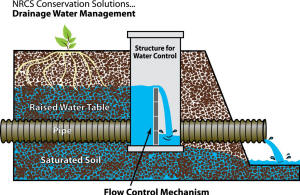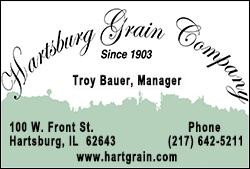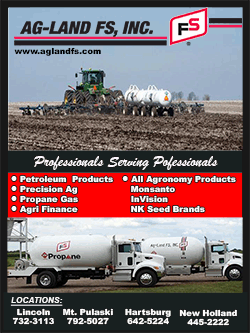|
 Corn and soybeans are dependent on the right
amount of rain at key times. Plants that develop the deepest roots
produce the healthiest plants and highest yields. Corn and soybeans are dependent on the right
amount of rain at key times. Plants that develop the deepest roots
produce the healthiest plants and highest yields.
Under ideal circumstances, moisture levels germinate seed, and then
subsurface roots begin their growth in direct correlation to plant
leaf development above the soil's surface. In a perfect timing, the
water table recedes allowing oxygen to surround the root, and all
season it continues: roots continue to stretch deeper toward the
water source with a continuous balance between moisture, oxygen and
nutrients.
Logan County's predictably unpredictable soil moisture conditions
The challenge to every farmer on earth - the weather. More
prominently precipitation - when it falls, how it falls, when it
doesn't fall, and other weather scenarios.
The winter of 2013 is a prime example of unpredictability when a so
called 'real winter' occurred. Farmers probably remember that while
picturesque with heavy snow and bitter cold, the soil frost line
reached deeper and colder than the current norm. Come spring
planting season, soils were slow to warm and quite wet pushing into
the narrow window of planting time.

It is always a guessing game with different challenges each season.
So much so that anytime a measure of control can be added, within a
reasonable cost and promises economic returns, it seems like a good
idea to research it.
Fields often plagued with standing water may hinder planting or
harvest - or in midseason can drown standing crops. Where this
problem occurs perennially, drainage tiles strategically placed
three to five feet below the surface aid at ridding fields of excess
water in a timely fashion.
Here's the idea that farmers might consider
When simple controls are added, these same tiles can significantly
increase production.
On a small acreage where the gradient is only one- to two-foot, a
single shutoff valve can be added to the field tile for a relatively
small expense.
Larger tiled fields, or where there are more changes in soil
gradient, can also be controlled by placing strategically located
stacks (valves that hold back water to set levels) to manage water.
Using soil moisture sensors, the water levels can be adjusted for
optimum plant development throughout the season.
Controlling the water table:
- Allows the farmer into fields to plant and harvest
- Keeps ground water available to plants
- Allows aeration for roots
- Keeps nitrogen, phosphorous and other nutrients available to
plants as they are needed

Drainage Water
Management is the process of managing the timing and the amount of
water discharging from agricultural drainage systems. A water level
control structure is installed in the tile line and allows for
management of the tile outlet elevation.
- USDA Natural Resources Conservation Service

The USDA’s Natural Resources Conservation Service (NRCS)
defines drainage water management (DWM) as, "the process of managing
the timing and the amount of water discharged from agricultural
drainage systems. DWM is based on the premise that the same drainage
intensity is not required at all times during the year. With DWM,
both water quality improvement and production benefits are possible.
Water quality benefits are derived by minimizing unnecessary
drainage, reducing the amount of nitrate that leaves farm fields.
DWM systems can also retain water in fields that could be used for
crop production later in the season--when you need it. Producers who
use DWM enjoy being able to better control their drainage water
instead of the water always controlling them."
One local farmer near Atlanta had a valve installed on his drainage
several years ago and considers it to be one of his best
investments. Dave Bishop says, "We absolutely keep that tile shut
anytime except for when we have to drain it to get it dry. We drain
it to plant, and if I need to keep the plants from drowning out." As
an organic farmer he says, "I worked hard to get those nutrients
that come through here. What runs off would go into the creek."

This simple box
integrated with the ground tile outlet contains the control lever
for holding back water for moisture and nutrients, or letting it
flow when need be to drain soggy fields.
After installing the valve he saw increasingly higher
yields each year. He credits in part, retaining nutrients that were
previously lost in drainage water and having those get built back up
within his soils.

Bishop compares the cost, "Out of an
$80,000 tile project, the valve costs approximately $700 and it pays
for itself in several ways – keeping ground moisture for dry parts
of the season, and the bigger savings is in nutrients that are not
washed away."

The box (that eats
cell phones from your shirt pocket if you lean over it.) The only
recommendation for maintenance is to keep side lever glides greased,
and it should last the life-time of the drainage system.
[to top of second column] |
 Mark Leesman of Leesman Tiling,
Atlanta said they have installed eight or 10 control valves and
while he has not been given any specific results, "all reports I
have heard are positive." Leesman also said he has installed control
boxes on owned and cash rent land. He said, "So far my experience
has been the landowner has paid for the control structure."
Leesman said the cost depends on the size of the tile it is
installed in and the depth. Installing the box has averaged $1,300 -
$1,400, with labor and material average cost is $2,800 - $3,500. He
says that longevity should be the life of the tile as it is made
from plastic and stainless steel.
He points out that a really rolling farm would need so many boxes it
would likely be impractical.
Resource Conservationist with the Logan County Soil and Water
Conservation District Steve Bracey agrees that you have to have the
right set of circumstances for it to work properly. He says, "Most
systems are for smaller acreages that can be confined to only the
producer’s land. Generally, you need pretty flat land and a small
drainage area of 20-40 acres that is confined on your property.
Clarifying, he adds, "You need to be sure that the tile line does
not extend on to a neighbor’s property or you may be adversely
affecting their drainage."
Bracey says that any local contractor that does tiling work would be
able to install a controlled drainage system using boxes or stacks.
The agency also has an engineer that could aid in a plan.
Currently, there are funding opportunities through the Environmental
Quality Incentives Program (EQIP) with NRCS. Interested producers
may apply through our office, Bracey says. The Conservation
Stewardship Program also has a couple of options for producers who
have a valid resource concern, he added.

According to the Natural Resources Conservation Service (NRCS)
controlled tile drainage research performed in several states has
been shown to decreased nitrate losses by approximately 45 percent
and the amount of water drained from fields by about 40 percent.
If you have drainage in place or are considering adding drain tiles,
it might be worth adding this overlooked, simple and low cost
control. Local resources:
Bedolli Excavating & Tiling
Andy/Brittney Bedolli
bedolliexcavating@ymail.com
217-638-2026
12506 Lynn Rd.
Buffalo, IL 62515
Coers Excavating
Mark & Beth Coers
217-376-3868
PO Box 21
Emden 62635
D & D Sewer
Ron "Pete" Helton
ronaldh217@alo.com
217-732-8137
620 Keokuk St.
Harold Goodman Excavating & Trucking
606 1400th St.
732-8683
Grosch Irrigation Co.
sbubert@groschirrigation.com
Ph. 482-5479
13590 N. SR 29
Mason City 62664
Humphrey's Tiling & Excavating
Larry Humphrey
digger_dad@hotmail.com
Ph. 217-519-3658
7741 Hallsville Rd.
Clinton 61727
Leesman Tiling
Mark Leesman
mleesman3@gmail.com
217-519-1992
1569 2575th St
Atlanta 61723
Ward Tiling
Mellisa Ward
wardtilinginc@gmail.com
217-248-4229
639 1250 E St.
Mount Sterling 62353
Additional planning and potential financial resources:
NRCS Programs
https://www.nrcs.usda.gov/wps/portal
/nrcs/main/il/programs/financial/eqip/

Logan County contact:
Steve Bracey
Steve.Bracey@il.nacdnet.net
Phone # - 217-735-5508 Ext. 3
Reference materials:
Drainage Water Management Plan Sheet
https://www.nrcs.usda.gov/wps/portal/
nrcs/detail/il/newsroom/factsheets/?cid=nrcs141p2_031323
Nutrient Stewardship in
collaboration with the Fertilizer Institute
http://www.nutrient stewardship.com/
implementation/subsurface-tile-drainage-management/
American Society of Agronomy study of phosphorous in drain tiles and
surface run off: Tile drains a major path for phosphorus loss,
studies find
https://www.agronomy.org/science-news/tile-drains-major-path-phosphorus-loss-studies-find
|